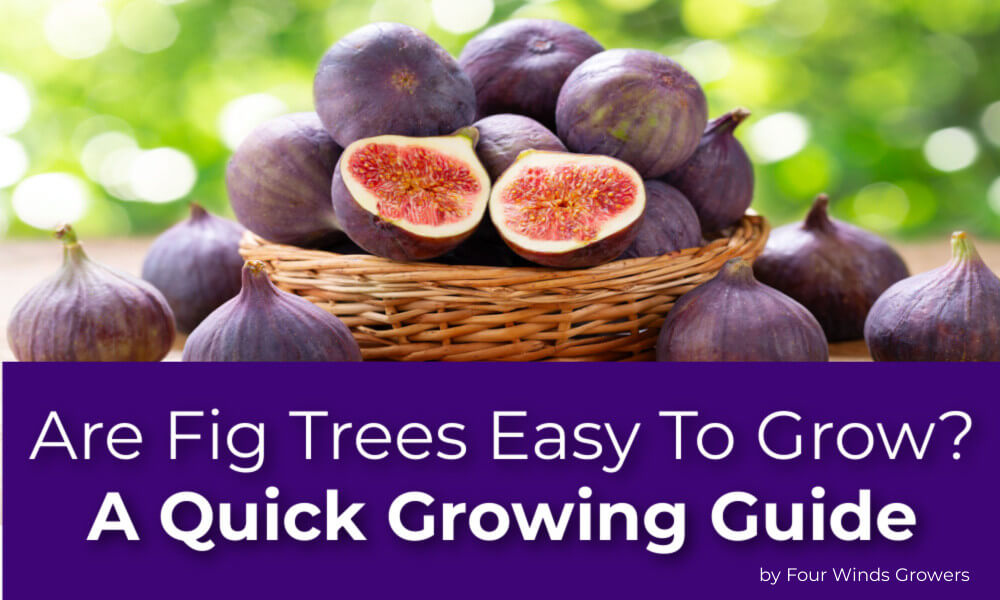Are Fig Trees Easy To Grow?
Fig trees are easy to grow! They are low maintenance and drought tolerant once they get established. They can also adapt to a wide range of climates and soil types and are great in containers. Although figs are quite vigorous growers, they can be kept to any size with regular pruning.
Planting
To plant your fig tree, choose a location with at least 8 to 10 hours of sunlight, always favoring the morning sun. Now that you have chosen the right spot, dig a hole deep enough to cover the root ball. We recommend digging a hole in a cone shape and planting the tree to the center of the cone. In heavy soils, mounding to 12 inches above the soil line is recommended. Lightly tamp (pack) down soil several times while backfilling the hole to avoid air pockets. After planting, water the tree deeply to settle the soil firmly around the roots. Make a basin for future watering. Do not apply fertilizer at planting time.
When transplanting check for roots collecting at the bottom of the pot. Gently loosen up the roots at the bottom to help them quickly extend into the surrounding soil. This is also recommended when painting in containers.
When planting in a container select premium potting soil and a ¼ inch bark. Mix the total volume of the container with a mixture of 2/3 potting soil and 1/3 the ¼ inch bark. This will provide a well-draining soil mix that will be perfect for your new tree.
Watering
The number one reason for fig loss in the first 2 years is poor draining soils. Become familiar with how your location drains and mounds to 12 inches above the soil line where drainage is poor. Figs are quite drought-tolerant once establish but water management in the first 2 years is critical.
Good water management includes regular irrigation and mulching to get trees established. Regular irrigation on established figs helps to improve size and juiciness. Once established figs require little water.
Pruning
Unpruned fig trees can spread 25’ or more. Figs will produce a thick dense canopy with little pruning. Figs can be held to any height with regular pruning. They make an ideal plant for espalier or as a patio container plant.
Many varieties bear an early crop called a breba crop, usually in early summer. The later crop called the main crop comes in late summer to early fall. This is something to keep in mind if you are pruning because breba crops form on last year's growth.
Fertilizing
In general, fig trees do not require regular fertilizing. Excessive applications of nitrogen can hurt fruit quality. The one exception is for figs grown in containers, which should be fed three or four times a year with a balanced fruit tree fertilizer.
Cold Weather Protection
Fig trees are most susceptible to cold injury when going into dormancy. Small young trees are particularly sensitive to freeze and care should be taken to protect or delay planting until all danger of frost has passed. A mature tree when dormant can withstand much colder temperatures. However, this varies by variety and care should be taken to select varieties that are suited to your area. Some varieties of figs can withstand temperatures as low as -10 degrees
After freeze damage occurs, give the tree ample time to grow before removing the frozen limbs. Prune frost-damaged branches in the spring once the threat of heavy frost has passed.
Harvesting
Some varieties of figs can bear two crops per year. The first crop, known as the breba crop, is produced in the spring on the previous year's growth. The second, main crop is produced in the fall on that year's growth.
For best quality, allow figs to ripen on the tree, and pick as they become somewhat soft. Some areas such as the southern seaboard of the United States deal with on-the-tree spoilage or souring caused by microorganisms in the fully ripe fruit. These organisms are usually carried into the open eye of the fig by insects, particularly the dried fruit beetle. Frequent harvest and the removal of overripe, spoiled figs can greatly reduce spoilage problems. Selecting varieties that have a “Closed Eye” will easily deal with the problem.
Check out Growing Figs for more information!




